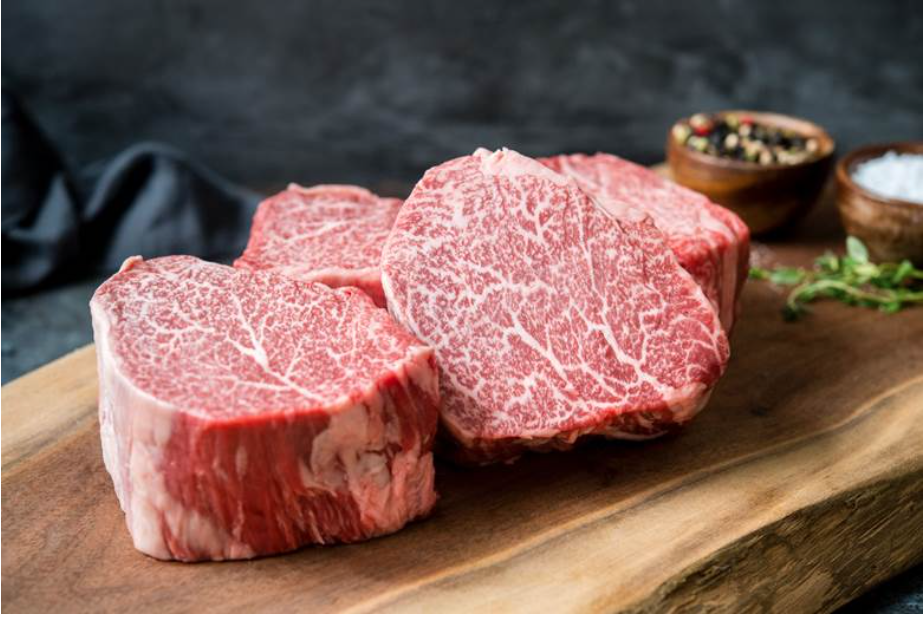What? 150 dollars for a piece of meat! Are you serious?! Why? Well… Wow.
Wagyu steak is the best steak in the world. But, what exactly is it? What makes it so great and the price so high?
What is Wagyu? Is All Wagyu Created Equal?
When translated, Wagyu means “Japanese cow”. There are four types of cows used for Wagyu beef: Kuroge (Black), Aakage (Brown), Nihon Tankaku (Shorthorn), and Mukaku (Polled).
The Japanese Meat Grading Association grades all Wagyu beef on a scale that includes a combination of a letter A to C and a number 1 to 5. The best possible grade for a piece of meat is A5 (costs upward of $120 per pound).
The A to C portion is determined by the amount of meat that can be harvested from the cow. Before the slaughter, calculations are made of the percentage of meat, fat, and bone found in the cow. The higher the percentage of meat, the better. After the processing comes the true test: the grading 1 to 5. Multiple factors play a role in the grading: marbling, the ratio of fat to lean meat (more fat is better), color (a mid-tone, not too light, not too dark is best), and firmness (a good balance between tenderness and structural integrity is desired).
This grading process is applied to Japanese Wagyu only. American Wagyu, which is often served in dishes across the United States, does not follow the strict regulations and grading processes of its Japanese counterpart. That is why you can find Wagyu tacos for $18. There is nothing wrong with American Wagyu, however, it is simply not the same as the true Japanese Wagyu.
Why is Wagyu So Great?
How the Cow is Raised and Fed
Japan’s Wagyu cows are raised in the most humane and stress-free environments possible. Farmers try to avoid vigorous activity for the cows; stress creates tension in their muscles and produces tougher meat. Conversely, lack of tension throughout the cow’s life produces an impressive fat content and helps boost a cut’s score on the aforementioned grading scale.
Japanese Wagyu cows do not ingest harmful hormones and are rarely treated with antibiotics (practices that are unfortunately common in the United States). Moreover, Wagyu cows are grass-fed. Farmers use rotational grazing to move cows from pasture to pasture and reduce the risk of overgrazing. The grass the cows eat is grown on soil enriched with natural fertilizers such as compost and manure.
The Wagyu-Angus crossbred cow that creates American Wagyu feeds on industrial corn and is not raised under the impressively humane conditions found in Japan.
Health Benefits
The health benefits of Wagyu beef far exceed those of typical U.S. meat. Studies have shown that America’s corn-fed cows produce meat that contains “more saturated fat and less omega-3 fatty acids” (The Omnivore’s Dilemma, M. Pollan), and are treated with hormones and antibiotics that contribute to health problems such as cancer and affect hormonal development. Conversely, Japanese Wagyu beef has a large amount of monounsaturated fat, which is considered ‘heart-healthy’ and lowers LDL cholesterol while increasing HDL cholesterol. In turn, this reduces risk factors for cardiovascular diseases. To add to the bargain, Wagyu is extremely rich in omega-3 and omega-6 fatty acids. Omega-3 fatty acids improve heart, brain, and metabolic functions, while omega-6 fatty acids provide the body with energy.
Great Taste
Finally, even if health benefits were thrown to the wayside, Wagyu simply tastes stinkin’ good! A perfect Wagyu steak will contain a large amount of intramuscular fat distributed evenly throughout the cut. Intramuscular fat has a lower melting point than other kinds of fat and melts during the cooking process. This creates a buttery, juicy flavor in Wagyu, and the reason why Wagyu often comes with the tag: “melts in your mouth”. The best way to eat Wagyu is by keeping it simple: prepare medium-rare via grilling or searing and season with a sprinkle of salt and pepper. Creating a dish out of Wagyu such as a ‘Wagyu Burger’ does a disservice to the delicacy.
Is a $150 steak worth it? You’ll have to decide for yourself. But, finding Japanese Wagyu in America is often challenging. There exist online vendors such as ‘The Wagyu Shop’ (https://wagyushop.com) that import authentic Wagyu to America and deliver it for home consumption. However, restaurants that serve true Japanese Wagyu are not always easily available. There are a few (not many) high-end steakhouses and Japanese restaurants such as Barclay Prime in the area that offer Japanese Wagyu.
In the end, ordering Wagyu is a once-in-a-lifetime experience and, as it turns out, proves to be significantly healthier and more sustainable.



